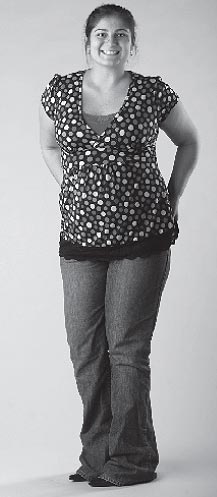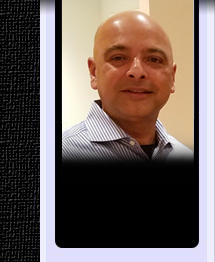
Melissa Martinez owes her
miracle to the
surgical procedure
known
as staged
bilateral hip
replacement.
And, her miracle
worker
is orthopedic
surgeon,
George Verghese,
MD.
Her miracle
is having
the ability to
simply walk
without pain
or assistance.
While it
sounds easy
enough, there
was a point
in her life not
too long ago
when she
wondered if
she’d ever be
able to stand
up straight
or move
from here to
there without
a walker or
crutches.
Download this article in PDF |
|
“Miracles don’t happen every
day.” We’ve all heard that expression
so many times, we’re
pretty much conditioned to
thinking that the only place
miracles do happen is in the
movies—that is, every holiday
season on 34th St.
But, when it comes to the
subject of miracles, 26-year-old
Melissa Martinez is a true believer.
There is no doubt in her
mind that a miracle has graced
her life. And, when you see the
smile on her face and the confidence
in her step, she’ll have
you believing in them, too.
Her miracle is having the
ability to simply walk without
pain or assistance. While it
sounds easy enough, there
was a point in her life not too
long ago when she wondered
if she’d ever be able to stand
up straight or move from here
to there without a walker or
crutches. The pain in her hips
was so excruciating that being
able to stroll leisurely around
the block with her young son
in a stroller wasn’t a dream—it
was an impossibility.
Melissa owes her miracle to
the surgical procedure known
as staged bilateral hip replacement.
And, her miracle worker
is orthopedic surgeon, George
Verghese, M.D.
“My surgery was the miracle of all miracles,” she enthuses.
“Thanks to Dr. Verghese, I have
gone from years on crutches, being
pushed in a wheelchair and
unable to stand up straight to
life as it used to be. Now, I get
up and go—without thinking,
without pain. It’s a tremendous
gift. I lived with pain in my
hips for so long, I just marvel
that it is truly gone. That’s the
miracle.”
Melissa’s medical problems
surfaced when she was a senior
in high school. She was a varsity
cheerleader and active in
several sports and many school
projects and events. But, she
was constantly ill and “always
ached all over”. Eventually and
after abandoning her favorite
activities, she was diagnosed
with lupus, a chronic, inflammatory,
autoimmune disease.
Lupus is a type of arthritis
that affects the joints, skin and
other organs.
“I battled the worst of the
worst with this illness. It led to
problems with blood pressure,
leaking valves, swelling of the
pericardium (sac around the
heart), seizures, migraines,
kidney failure and dialysis.”
To help manage the pain and
inflammation caused by lupus,
she began taking prednisone,
a prescriptive corticosteroid
medication. It took the better
part of a year until she began
to feel better and “normal”
again. “Finally, I felt healthy. I
even started jogging,” Melissa
said.
Slowly, though, she began
experiencing pain in her hips.
Over time, it intensified so
dramatically, she was incapacitated
and unable to put
any pressure at all on her legs.
X-rays and MRIs revealed that
Melissa had avascular necrosis
of both hip joints or AVN due to
prolonged use of prednisone.
AVN is a disease that results
from the temporary or permanent
loss of blood supply to the
bones. Without blood, the bone
dies and collapses. This disease
is also known as osteonecrosis,
aseptic necrosis or ischemic
bone necrosis.
Although it can occur in any
bone, AVN affects the ends of
long bones most commonly,
such as the femur (bone extending
from the knee joint
to the hip joint). Up to 20,000
people are diagnosed with AVN
each year. Generally, it affects
people between the ages of 30
and 50.
The amount of disability that
results from AVN depends on
what part of the bone is affected
and how large an area
is involved. Over the course
of AVN, the healing process is
usually ineffective as the bone
tissues break down faster than
the body can repair them. If
left untreated, the disease progresses
to the point where the
bone collapses, and the joint is
destroyed, causing severe pain,
stiffness and deformity.
Loss of blood supply to the
bone can be caused by an injury
or by risk factors, such as
medications including steroids,
or by excessive alcohol intake.
Studies show that long-term
systemic corticosteroid use is
associated with 35 percent of
all cases of AVN and that it is
more likely to affect both hips
(when occurring in the hip). In
Melissa’s case, the tissue in the
ball of her hips had died and
collapsed.
Melissa spent two-and-a-half
years in constant pain and
dependent completely on assistance
to walk. There were
even times when the pain was
so horrific that she could not
stand or put pressure of any
degree on her hips and spent
days in bed curled in the fetal
position for relief. She was seen
by several physicians and at
Chicago hospitals “who only
seemed to be able to provide
temporary fixes to alleviate
the pain.”
The miracle began when she consulted Dr. Verghese. “When
I met Melissa, she was crouched
over and almost squatting all
of the time. She couldn’t stand
up straight and was in unyielding
pain. Her condition is not
uncommon as a result of a steroid
regime to manage lupus.
She had reached the point that
her only choice for relief was to
replace both of her hips,” said
Dr. Verghese.
Bilateral hip replacement, he
explains, is a painful procedure
that can result in significant
blood loss.
Due to Melissa’s problems
with renal failure, Dr. Verghese’s
plan was to replace
her left hip and allow several
days before surgery on her
right hip.
However, due to the stress
of the first surgery, Melissa’s
second procedure was delayed
for several weeks. Dr. Verghese,
who completed his fellowship in
joint replacement at Harvard, used high-density plastic hips
for her surgery, which occurred
at Provena St. Mary’s Hospital
in Kankakee. “In Melissa’s
case, they have the potential to
last a lifetime,” he says.
Her recovery from the second
procedure was quicker and
dramatically less stressful.
And, the results are indeed a
miracle. “It’s strange to look
in the mirror and see myself
standing so tall and straight.
The surgery allowed me to start
living my life again. I can walk and stand pain-free,” Melissa
beams.
Dr. Verghese will follow Melissa’s
recovery and progress on
a long-term basis. Her case, he
points out, is testament to the
fact that the highest medical
technology, skill and nursing
care are available right here
in the community, “eliminating
the need to travel outside
of the area.”
These are the types of miracles,
he says, that happen in
Kankakee.
Courtesy of the The Herald - January 6, 2009
|





